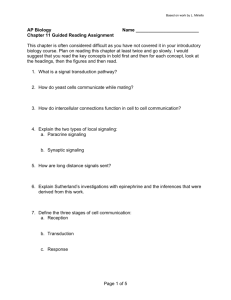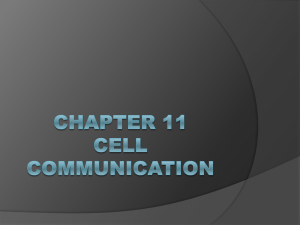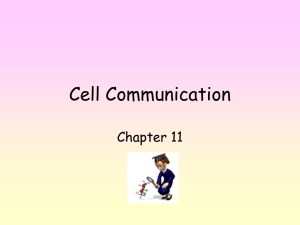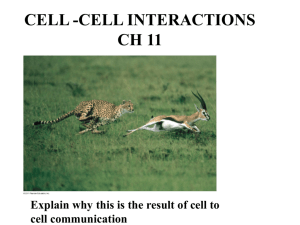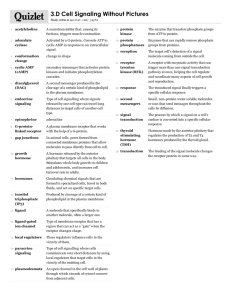Lecture_-_14
advertisement
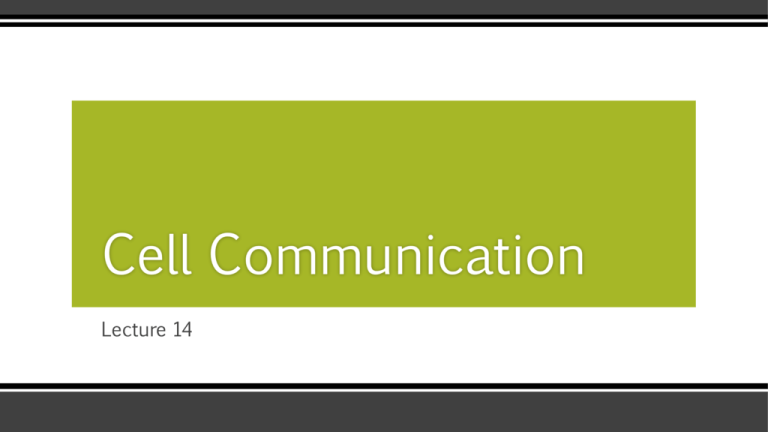
Cell Communication Lecture 14 Outline ▪ Review of Photosynthesis – Finish up Cam plants ▪ Cell-Cell Communication – Local vs Long distance – Three Stages of Signaling ▪ Reception ▪ Transduction ▪ Response Photosynthesis - Overview ▪ “Fixing” Carbon ▪ 6 CO2 + 12 H2O + Photons (light energy) C6H12O6 + 6 O2 + 6 H2O ▪ A redox reaction: becomes reduced Energy 6 CO2 6 H2O C6 H12 O6 6 O2 becomes oxidized Figure 10.UN01 CO2 H 2O Light NADP ADP + Pi Light Reactions Calvin Cycle ATP NADPH Figure 10.6-4 Chloroplast O2 [CH2O] (sugar) Photosynthesis – Light Dependent Reaction – Electron flow Photosynthesis – C3 Reveiw The C4 pathway C4 leaf anatomy Photosynthetic cells of C4 plant leaf Mesophyll cell PEP carboxylase Mesophyll cell Bundlesheath cell Oxaloacetate (4C) Vein (vascular tissue) PEP (3C) ADP Malate (4C) Stoma Bundlesheath cell CO2 ATP Pyruvate (3C) CO2 Calvin Cycle Figure 10.20 Sugar Vascular tissue Photosynthesis – Cam plants ▪ Evolved to conserve water – Many succulents, cactus, pinapple ▪ Sub set of C4 photosynthetic plants ▪ Close their stomata during the day ▪ Open them at night – – – – Lets in CO2 Fixes it in the same way that C4 plants do However, malate gets stored in vacuoles During the day it gets pumped back into the mesophyll cell and the calvin cycle can proceed. Sugarcane Pineapple C4 CAM CO2 Mesophyll Organic acid cell CO2 1 CO2 incorporated (carbon fixation) Organic acid Night Figure 10.21 CO2 CO2 Bundlesheath cell Calvin Cycle Sugar (a) Spatial separation of steps 2 CO2 released to the Calvin cycle Calvin Cycle Day Sugar (b) Temporal separation of steps Cell Communication ▪ Essential for multicellular and unicellular organisms – There are universal mechanisms that are conserved – Communication is mostly through chemical signals ▪ Fight or flight – release of epinephrine Cell-Cell Communication – Example – Yeast ▪ Two mating types – Type a and type a ▪ Different types locate each other via secreted factors that are specific to each type Cell-Cell Com. – Signal Transduction Pathways ▪ A series of steps that convert a signal on a cell’s surface into a specific cellular response ▪ Pathways are conserved – Indicates that pathways evolved in prokaryotes and were later modified in eukaryotes Cell – Cell Com. – Local Signaling ▪ Cells in multicellular organisms communicate via chemical messengers ▪ Animal and Plant cells have cell junctions – Directly connect the cytoplasm of adjacent cells ▪ Local signaling – Cells may communicate by direct contact or cell-cell recognition – Local Regulator: messenger molecules that travel short distances Plasma membranes Gap junctions between animal cells (a) Cell junctions Figure 11.4 (b) Cell-cell recognition Plasmodesmata between plant cells Figure 11.5a Local signaling Electrical signal along nerve cell triggers release of neurotransmitter. Target cell Secreting cell Local regulator diffuses through extracellular fluid. (a) Paracrine signaling Neurotransmitter diffuses across synapse. Secretory vesicle Target cell is stimulated. (b) Synaptic signaling Figure 11.5b Cell-Cell Com. – Long-distance signaling Long-distance signaling Endocrine cell Blood vessel ▪ Hormons are long distance messengers – Cells that are supposed to respond to signals will have specific receptors for that signal Hormone travels in bloodstream. Target cell specifically binds hormone. (c) Endocrine (hormonal) signaling Cell-Cell Com. – Three stages of cell signaling ▪ Reception – Signal is received by specific cell surface molecules ▪ Transduction – Signal is passed from molecule to molecule ▪ Response – Targeted response to the signal is initiated EXTRACELLULAR FLUID 1 Reception Receptor Figure 11.6-1 Signaling molecule CYTOPLASM Plasma membrane EXTRACELLULAR FLUID 1 Reception CYTOPLASM Plasma membrane 2 Transduction Receptor Relay molecules in a signal transduction pathway Figure 11.6-2 Signaling molecule EXTRACELLULAR FLUID 1 Reception CYTOPLASM Plasma membrane 2 Transduction 3 Response Receptor Relay molecules in a signal transduction pathway Figure 11.6-3 Signaling molecule Activation of cellular response Cell-Cell Com. – Three Stages - Reception ▪ A signaling molecule binds to a receptor protein – Receptor is usually a membrane bound protein – Causes a shape change – Shape change is usually the first step in the transduction of the signal ▪ Receptor binds a LIGAND – Binding is highly specific Cell-Cell Com. – Three Stages – Reception – Three types of Receptors ▪ G protein-coupled receptors ▪ Receptor tyrosine kinases ▪ Ion channel receptors Cell-Cell Com. – Reception – G Protein Coupled Receptors (GPCRs) ▪ The largest family of cell surface receptors Signaling molecule binding site ▪ Works with the help of a G protein – G protein acts like an on/off switch ▪ If GDP is bound to the G protein, it is inactive Segment that interacts with G proteins G protein-coupled receptor Figure 11.7b G protein-coupled receptor CYTOPLASM 1 Plasma membrane Activated receptor Enzyme Inactive enzyme GTP GDP GDP G protein (inactive) Signaling molecule 2 GDP GTP Activated enzyme GTP GDP P 3 Cellular response 4 i Cell-Cell Com. – Reception – G Protein Coupled Receptors (GPCRs) ▪ Importance of G- Proteins – ~800 different GPCRs ▪ Detect photons, hormones, growth factors, drugs, neurotransmitters… – Implicated in many diseases ▪ Diabetes ▪ Blindness ▪ Allergies ▪ Depression ▪ Cardiovascular defects – Beta adrenergic receptors… ▪ Cancers – 30% of Modern drugs target GPCRs Cell-Cell Com. – Reception – Receptor Tyrosine Kinases (RTKs) ▪ Receptors that attach phosphates to tyrosines – Can trigger multiple pathways at once – Often associated with cancers Signaling molecule (ligand) Ligand-binding site Signaling molecule a helix in the membrane Tyrosines CYTOPLASM Tyr Tyr Tyr Tyr Tyr Tyr Receptor tyrosine kinase proteins (inactive monomers) 1 Tyr Tyr Tyr Tyr Tyr Tyr Tyr Tyr Tyr Tyr Tyr Tyr Dimer 2 Activated relay proteins Figure 11.7c 3 Tyr Tyr P Tyr Tyr P Tyr Tyr P Tyr Tyr P Tyr Tyr P Tyr Tyr P 6 Activated tyrosine kinase regions (unphosphorylated dimer) ATP 6 ADP Fully activated receptor tyrosine kinase (phosphorylated dimer) 4 P Tyr Tyr P P Tyr Tyr P P Tyr Tyr P Inactive relay proteins Cellular response 1 Cellular response 2 Cell-Cell Com. – Reception – Receptor Tyrosine Kinases (RTKs) ▪ Importance of RTKs – 58 unique RTKs – ~20 classes of RTKs – Important for many growth factors ▪ Regulate growth and differentiation – Cytokines (small signaling proteins that are important in immunity) – Hormones Cell-Cell Com. – Reception – Ligand-gated ion channel ▪ Act as a gate, opening when the ligand binds – When open, it allows specific ions to flow through a channel in the receptor – Na+ and Ca+ channels are examples Figure 11.7d 1 Signaling molecule (ligand) 3 2 Gate closed Ligand-gated ion channel receptor Ions Plasma membrane Gate closed Gate open Cellular response Cell-Cell Com. – Reception – Ligand-gated ion channel ▪ Importance of Ion gated channels – Many neurotransmitters are Ligand-gated ion channels – Many are the site at which anesthetic agents as well as ethanol act – GABAA receptor ▪ Gamma-aminobutyric acid ▪ On of the chief neurotransmitters in the central nervous system – GABA agonists – drugs that stimulate the GABA receptors, produce a sedative effect, anti anxiety, muscle relaxants ▪ Ethanol, barbiturates (Luminal – antieplileptic, Phenobarbital- sedative), benzodiazepins (Xanax, Ativan, Valium) – GABA antagonists - stimulants ▪ Note: GABAB receptor is a GPCR Cell-Cell Com. – Reception – Intracellular Receptors ▪ Found in the cytosol or nucleus of target cells – Usually activated by small or hydrophobic chemical messengers ▪ Steroids and thyroid hormones – An activated hormone-receptor complex can directly turn on a gene ▪ A transcription factor – initiates and propagates gene transcription Hormone (testosterone) EXTRACELLULAR FLUID Plasma membrane Receptor protein DNA Figure 11.9-1 NUCLEUS CYTOPLASM Hormone (testosterone) EXTRACELLULAR FLUID Plasma membrane Receptor protein Hormonereceptor complex DNA Figure 11.9-2 NUCLEUS CYTOPLASM Hormone (testosterone) EXTRACELLULAR FLUID Plasma membrane Receptor protein Hormonereceptor complex DNA Figure 11.9-3 NUCLEUS CYTOPLASM Hormone (testosterone) EXTRACELLULAR FLUID Plasma membrane Receptor protein Hormonereceptor complex DNA Figure 11.9-4 mRNA NUCLEUS CYTOPLASM Hormone (testosterone) EXTRACELLULAR FLUID Plasma membrane Receptor protein Hormonereceptor complex DNA Figure 11.9-5 mRNA NUCLEUS CYTOPLASM New protein Cell-Cell Com. – Transduction ▪ Cascades of molecular interactions relay signals from receptors to target molecules in the cell – Usually involves multiple steps – Can amplify a signal ▪ Just a few molecules can produce a large cellular response – Multiple steps in the pathways provide opportunities for coordination and regulation ▪ Can be controlled and various steps Cell-Cell Com. – Transduction ▪ Cascades are usually made up of proteins – One protein activates another, which activates another, which activates another… ▪ Down the chain until the final protein that produces the response is activated – Each step the signal is transduced into a different form ▪ Usually a shape change Cell-Cell Com. – Transduction – Protein Phosphorylation & Dephosphorylation ▪ Many pathways transmit the signal via phosphorylation of proteins in the chain – Called Kinase Cascades ▪ Protein Kinase is an enzyme that phosphorylates a protein – Phosphate group comes from ATP Signaling molecule Receptor Activated relay molecule Inactive protein kinase 1 Active protein kinase 1 Inactive protein kinase 2 ATP P Figure 11.10 ADP P Active protein kinase 2 PP i Inactive protein kinase 3 ATP P ADP Active protein kinase 3 PP i Inactive protein ATP P PP i ADP P P Active protein Cellular response Cell-Cell Com. – Transduction – Second Messengers ▪ First messenger is the ligand that binds to the receptor of a specific pathway ▪ Second Messengers are small, nonprotein, water-soluble molecules or ions that spread throughout a cell by diffusion – They spread the message across the cell ▪ They are part of GPCR and RTK pathways ▪ Cyclic AMP and calcium ions are common second messengers Cell-Cell Com. – Transduction – Second Messengers – Cyclic AMP • Cyclic AMP (cAMP) is one of the most widely used second messengers • Adenylyl cyclase, an enzyme in the plasma membrane, converts ATP to cAMP in response to an extracellular signal Figure 11.11 Adenylyl cyclase Phosphodiesterase Pyrophosphate P ATP P H2 O i cAMP AMP Cell-Cell Com. – Transduction – Second Messengers – Cyclic AMP ▪ Many signal molecules trigger the formation of cAMP ▪ cAMP usually activates protein kinase A, which phosphorylates various other proteins ▪ Further regulation of cell metabolism is provided by G-protein systems that inhibit adenylyl cyclase First messenger (signaling molecule such as epinephrine) Adenylyl cyclase G protein G protein-coupled receptor GTP ATP cAMP Second messenger Figure 11.12 Protein kinase A Cellular responses Cell-Cell Com. – Response ▪ Cell signaling leads to regulation of transcription or cytoplasmic activities – Sometimes referred to as output response ▪ Signal transduction leads to the regulation of one or more cellular activities ▪ Response may occur in the cytoplasm or the nucleous – Many signaling pathways regulate the synthesis of enzymes & proteins by turning on or off genes – Often, the final activated molecule in the pathway may functions as a transcription factor Growth factor Reception Receptor Phosphorylation cascade Transduction CYTOPLASM Figure 11.15 Inactive transcription factor Active transcription factor P Response DNA Gene NUCLEUS mRNA Some pathways regulate the activity of enzymes rather than their synthesis Reception Binding of epinephrine to G protein-coupled receptor (1 molecule) Transduction Inactive G protein Active G protein (102 molecules) Inactive adenylyl cyclase Active adenylyl cyclase (102) ATP Cyclic AMP (104) Inactive protein kinase A Active protein kinase A (104) Inactive phosphorylase kinase Active phosphorylase kinase (105) Inactive glycogen phosphorylase Active glycogen phosphorylase (106) Response Figure 11.16 Glycogen Glucose 1-phosphate (108 molecules) RESULTS Can result broad changes like changes in cell shape CONCLUSION 1 Mating factor activates receptor. Wild type (with shmoos) formin Fus3 Mating factor G protein-coupled receptor Shmoo projection forming P Fus3 GDP Figure 11.17 GTP 2 G protein binds GTP and becomes activated. Fus3 Actin subunit P Phosphorylation cascade Fus3 Formin Formin P 4 Fus3 phosphorylates formin, activating it. P 3 Phosphorylation cascade activates Fus3, which moves to plasma membrane. Formin Microfilament 5 Formin initiates growth of microfilaments that form the shmoo projections. Cell-Cell Com. – Response – Fine-tuning the response ▪ There are four aspects of fine-tuning – – – – Amplification of the signal (and thus the response) Specificity of the response Overall efficiency of response, enhanced by scaffolding proteins Termination of the signal Cell-Cell Com. – Response – Fine-tuning the response - Amplification ▪ Enzyme cascades amplify the cell’s response ▪ At each step, the number of activated products is much greater than in the preceding step Cell-Cell Com. – Response – Fine-tuning the response – Specificity and coordination ▪ Different kinds of cells have different collections of proteins ▪ These different proteins allow cells to detect and respond to different signals ▪ Even the same signal can have different effects in cells with different proteins and pathways ▪ Pathway branching and “cross-talk” further help the cell coordinate incoming signals Figure 11.18 Signaling molecule Receptor Relay molecules Response 1 Cell A. Pathway leads to a single response. Activation or inhibition Response 2 Response 3 Cell B. Pathway branches, leading to two responses. Response 4 Cell C. Cross-talk occurs between two pathways. Response 5 Cell D. Different receptor leads to a different response. Cell-Cell Com. – Response – Fine-tuning the response – Scaffolding Proteins and Signaling Complexes ▪ Large relay proteins to which other relay proteins are attached – Can increase the signal transduction efficiency by grouping together different proteins involved in the same pathway – In some cases, may also help activate some of the relay proteins Figure 11.19 Signaling molecule Plasma membrane Receptor Scaffolding protein Three different protein kinases Cell-Cell Com. – Response – Fine-tuning the response – Termination of the Signal ▪ If ligand concentration falls, fewer receptors will be bound ▪ Unbound receptors revert to an inactive state

